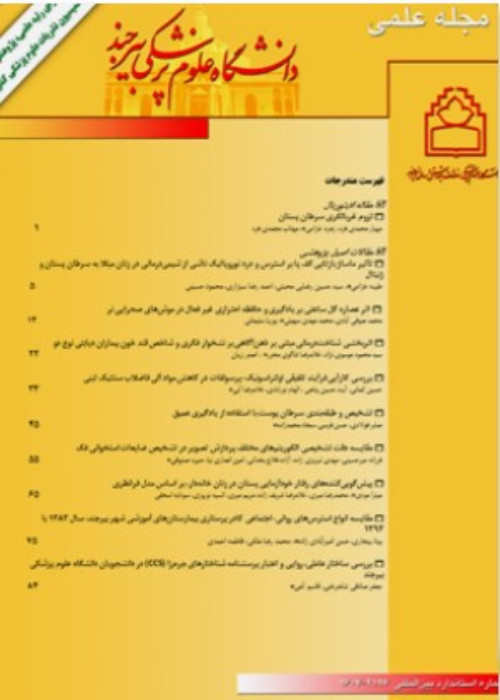Prevalence of malnutrition in under 6- year old children in South Khorasan in 2006
Author(s):
Abstract:
Background And Aim
Malnutrition is one of the important health problems throughout the world, particularly in developing countries, which has undesirable effects on mental and physical health of children. It is an underlying factor of infection and an important cause of child mortality in these countries. The aim of this study was to find out the prevalence of malnutrition in children under 6 in south Khorasan in 2006. Materials And Methods
This cross sectional and descriptive analytical study was done on 1807 children under 6 in south Khorasan, belonging to six urban and rural regions, applying multistage cluster sampling methodology. Data collection was done by trained family-health associates and family-health workers through measuring of weight and height for Seca, and structural questionnaires ANIS, and face-to-face interviews with mothers. To study malnutrition, three indices were used namely “weight to age” (underweight),”weight to height”(leanness),and “height to age”(shortness).The obtained data was analyzed by means of chi-square test, SPSS software and EPI-Info 2000, and α= 0.05 was taken as the significant level. Results
Out of 1807 children 51.7% were males, 52.2% were living in urban areas and 37% were under 24 months old and the rest over 24. Weight index showed that 52.2% were normal, 34.4% were lightly under weight, 11.7% moderately underweight and 1.2% were severely underweight. Prevalence of underweight had a significant relationship to habitation, mother's job and parent's education level. Regarding standing criteria 55% were normal, 28.4% were lightly short, 12.7% were moderate, and 3.9% were extremely short. Stunting had a significant relationship to habitation, age, mother's job and parent's level of education (P<0.05). Wasting criteria showed that 67.8% had normal wasting, 24.7% light wasting, 5.9% moderate wasting and 1.6% had severe wasting. This had a significant relationship to sex and habitation (P<0.05). Conclusion
With regard to high prevalence of malnutrition in children and its relationship to socio-economic variables, measures such as increasing parents’ education especially mother's knowledge, constancy of breast feeding until the age of 2 years, and promoting nutrition status of children under 6 years and mothers’ knowledge of children’s nutrition are recommended.Language:
Persian
Published:
Birjand University of Medical Sciences, Volume:15 Issue: 2, 2008
Page:
73
magiran.com/p572687
دانلود و مطالعه متن این مقاله با یکی از روشهای زیر امکان پذیر است:
اشتراک شخصی
با عضویت و پرداخت آنلاین حق اشتراک یکساله به مبلغ 1,390,000ريال میتوانید 70 عنوان مطلب دانلود کنید!
اشتراک سازمانی
به کتابخانه دانشگاه یا محل کار خود پیشنهاد کنید تا اشتراک سازمانی این پایگاه را برای دسترسی نامحدود همه کاربران به متن مطالب تهیه نمایند!
توجه!
- حق عضویت دریافتی صرف حمایت از نشریات عضو و نگهداری، تکمیل و توسعه مگیران میشود.
- پرداخت حق اشتراک و دانلود مقالات اجازه بازنشر آن در سایر رسانههای چاپی و دیجیتال را به کاربر نمیدهد.
In order to view content subscription is required
Personal subscription
Subscribe magiran.com for 70 € euros via PayPal and download 70 articles during a year.
Organization subscription
Please contact us to subscribe your university or library for unlimited access!



